老人与海冰山理论论文开题报告
- 格式:doc
- 大小:44.00 KB
- 文档页数:7
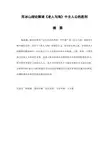
用冰山理论解读《老人与海》中主人公的胜利摘要被威谦、福克纳誉为“这代人最优秀的一个单篇”的《老人与海》是硬汉子海明威的力作,而对于《老人与海》的象征主义,评论界各执已见,海明威本人的解释也模棱两可。
而小说中主人公圣地亚哥和生存环境、大海、鲨鱼、小孩等角色实际上并非角色本身,表面上简单的角色及故事情节有着深刻的象征意义,所以笔者希望从文章的主人公、其生存环境等各个方面对其象征主义进行剖析、总结和归纳《老人与海》的象征手法以及海明威的人生观在各象征因素中的体现,以期能帮助读者更好地理解这部作品。
关键词海明威象征因素冰山原理生存环境人生观ABSTRACTThe Old Man and the Sea, praised by a famous writer as “the most excellent simple article in this generation”, is a masterpiece of the unyielding man—Hemingway. But with regard to the symbolism, it has been talked differently, and was equivocal in the explanation by Hemingway himself. The Protagonist, the living environment, the sea, the Shark, the Marlin are not themselves but have significant symbolical meaning. Here the author will analyze its symbolism thoroughly through some aspects such as the leading character,the living environment and Hemingway’s philosophy of life reflected by the symbols, with a view to help the reader get a better understanding of Ernest Hemingway's masterpiece.Key Words Hemingway the symbolic factors iceberg theory the living environment philosophy of life目录1 引言 (6)2 背景介绍 (7)3 作品的象征意义 (7)3.1 象征意义的含义 (7)3.2 老人与海中运用的主要象征 (9)4 海明威用象征手法在老人与海中反映出来的哲学生活 (10)4.1 老人与海中海明威的哲学生活 (10)4.2 通过象征手法反映海明威对生活的态度 (11)5 结论 (11)致谢辞.................................................... 参考文献.................................................. 附录CONTENTS1 Introduction (6)2 Introduction to the Background (7)3 The Symbolism in the Works (7)3.1 The Definition of Symbolism (7)3.2 Major Symbols in The Old Man and the Sea (9)4 Hemingway’s Philosophy of Life Reflected by the symbols in The Old Man and the Sea (10)4.1 Hemingway’s Philosophy of Life in The Old Man and the Sea (10)4.2 Hemingway’s Attitude towards the Society Reflected through the Symbol of the Sea (11)5 conclusion (11)Ackonwledgements ................................................................................. Reference……………………………………………………………......... Appendix…………………………………………………………….........1 IntroductionRegarded as a giant both in American literature and the world literature, Ernest Hemingway was born on July21, 1898, at Oak Park, Illinois. In the childhood, influenced by his father, Hemingway was interested in music, pictures, hunting, fishing and the like.His variety of interest, especially the love of fishing extremely affected all his life and he drew much writing inspiration from his fishing experience. Taking adventures also plays a vital role in his life and for the reason that he experienced the two world wars. As a noticeable representative of the “Lost Generation”, Hemingway published the books of this sort, The Sun Also Rises at the age of 26. Because the book chiefly deals with the living attitude of the post-war generation, especially the lives of those wounded soldiers and the loneliness and disillusionment of the modern people whose ideal was shattered at the time when “God is dead”, they thought life was nothing and meaningless. In this case, Hemingway became the spokesperson for the The Lost Generation.Actually the parable of a man’s struggle against the nature, The Old Man and The Sea was published in 1952. Acknowledged as his best works, the novel reinvigorated Hemingway’s literary reputation after the violent attacks,he received from Across the River and Into the Tress. The positive reaction that followed the novel included praise not only from the reviewers but also from a board spectrum of the mass, from ordinary readers to fellow men of letters. The publishing of this work showed that Hemingway had shown he could still achieve a major triumph, whether or not the reviewers and critics or the public could appreciate the true value of his achievement. The Old Man and the Sea was awarded the Pulitzer Prize in 1953 and Hemingway’s famous iceberg technique, which is a simple but highly suggestive style, was vividly embodied in the work, thus he was awarded the Nobel Prize for his “mastery of the art of modern narration”.2 Introduction to the BackgroundThe old Man and the Sea is a fable of an old man’s life which was told by Hemingway.Hemingway is a famous American writer of modern times. He is also an international literary celebrity in the world. His father is a prominent doctor, and also a dab at fishing and hunting. The influence of his father made him full of love with fishing and hunting. As a mouthpiece of “the lost generation”, Hemingway suffered cold shoulder and attack almost ten years in the commentary field. In order to save the desperate situation, Hemingway wrote a work that he firmly believes to be the best works in his life, which was called The Old Man and the Sea, which is the inheritance and dev elopment of Hemingway’s unyielding character.3The Symbolism in the Works3.1 The Definition of SymbolismSymbolism is an artistic movement in the late 19th century that tried to express abstract or mystical ideas through the symbolic use of images. In literature, it is a writing style of using something to stand for something else by reasoning of relationship, association, accident resemblance, or a visible sign of something invisible.As a master in literature, Hemingway uses very simple words and sentences to write some magnum opus, which is his iceberg technique that he uses in his work. He believed as a good writer, he didn’t need to reveal the action or characters clearly, obscurity can give us the aesthetic sense. So the words and sentences in his work are symbolic and suggestive. That is to say, one needs keep a close eye to read his works and read between the lines deliberately.3. 2 Major Symbols in The Old Man and the SeaThere are many symbols in this story, such as the old man, the boy, the sea, the shark, the marlin and etc. This paper only focuses on the important symbols and analyzes the deep meanings of them.3.2.1 The Old Man—the Best Expression to “the unyielding character”The Old Man and the Sea is a short simple novel that has been hailed as a classic.The story The Old Man and the Sea is about an old fisherman named Santiago who overcomes the great forces of nature. Not catching a single fish for eighty-four days, the old fisherman still keeps on trying without being despaired. He goes far out into the sea and catches a huge marlin after three day’s patient struggle. On his way home sharks come and attack, Santiago tries his best to fight but fails to prevent the marlin from being eaten. In the end he returns with nothing but the skeleton of the marlin. Many people believe that the novel is about the life of Hemingway himself. Because some parts of the story do relate to what Hemingway has experienced in his life.The old man--- Santiago is the last tragic hero that Hemingway portrays. Being poor and unlucky, his fate is sad, but he is not a man being easily defeated. Hemingway’s unyielding character is attached to the old man like a demon, which is the symbol of Hemingway’s unyielding character, which is regarded as an embodiment of Hemingway’s iceberg principle.Hemingway does not tell the story simply, but reveal his living experience, emotion and thought symbolically.We can see that the old man shows some traditional moral, we can’t deny that the old man is the best reflecting of the unyielding spirit of Hemingway’s.3.2.2The Boy— the Best Supplement for the Unyielding Man CharacterTaking the only boy whom he can depend on r for survival is Hemingway’s unique idea. Taking away is because the old man “has bad luck” and the boy’s parents force him to claim kinship with them.Before the child goes back, the struggle of the old man is isolate; the words of the child make clear that he becomes mature under the move and inspire, he faintly feels happy and the wish of brightness. So the image of the boy is the elaboration of the writer in making out the line of the story,and the information that the boy reflects is beyond the information that the writer hopes on the fish,the old man and sea. The boy helps him wh en the others deserts. “If the boy were here”. The story mentions it for nine times, which symbolizes that the child is the strength for the weak man when he fails and is disappointed.3.2.3 The Sea —the Symbol of Hemingway’s Survival Environment.In both the sea and the life, there are many possibilities that lie hidden from thecommon: some are gifts to be treasured and some are troubles to be defeated. Neither will be found unless man embarks on the journey.The sea is holding the balance in the whole story, it is the substance world that the old man depends on, it is all content of his living, the sea prepares the mystical big fish, it supplies a place to reveal the old man’s courage and will-power, the sea is a picture that means a lot. In the novel, Santiago embarks on a sea journey and encounters a giant marlin. He battles nobly to earn the treasure, and then fights against sharks to save the treasure. The struggle defines him as a real hero. Though he loses the marlin in the end, he has won the sea battle and honored himself.The sea is just like the society. Only a man faces and fights on it with courage, can he defeat the unchangeable fate and become the strong one of the life. Like the sea too, the society contains many hidden treasures or good chances and predators. 4.3.2.4The Shark —A Powerful Deputy of the Evil ForceThe shark stands for the evil side of the natural world. It symbolizes the destructive force of the society and the world.When Santiago is fighting with the marlin, the sea is calm, beautiful, which is harmonious with the nature. But the sharks smell the taste of blood, they come up one by one and destroy the harmony. Furthermore, they devour the old man’s trophy-great marlin, like the predators.When the old man wants to fish a big fish, he really catches a unprecedented big fish, his praise for the big fish, the big size of the body, the grace of the posture, the hugeness of the power, the beauty of the color can make us reminds of it. Those sharks can be seen as symbols of the evil force that obstruct people to achieve the perfect condition.3.2.5The Marlin—the Symbol of AchievementIn contrast to the shark, which stands for a bad part of nature, the giant marlin also has its symbolic meaning in the novel. It becomes a symbol of the ideal in life that challenges those who is eager for it.It is precisely through the effort to battle the huge marlin that Santiago proves his heroism and manliness. He finds the marlin worthy of a fight, and so he fights hardly.By realizing the life ideal, he proves himself a worthy fisherman. So a heroic and manly life is not self-sufficiency, it requires constant demonstration of one’s worthiness through noble action and struggle for the ideal in life.4 Hemingway’s Philos ophy of Life Reflected by the symbols in The Old Man and the SeaIn this novel, Hemingway has used many symbols. All these symbols have very important and special meanings. By understanding them, we can better understand the writer's philosophy of life.4.1 Hemingway’s Philosophy of Life in The Old Man and the SeaThe Old Man and the Sea is a song of praise about human spirit. Through the description of the sufferings Santiago endures and his courageous behavior in his fights with the marlin and the sharks, Hemingway intends to tell us his philosophy of life: although life is a lonely battle, it is a struggle that man should fight on with courage and endurance; and the “meaning” of life is not to be found in “success” or “failure”, but rather in the struggle itself.To Hemingway, life is a struggle to be borne, not like a burden, but as a challenge. He thinks that man has the power to struggle for life, no matter what result may be. According to him, human beings are not totally hopeless in the world. Even though he knows that the human struggle is useless in face of the natural forces, he encourages people to strive. In this sense, Hemingway’s philosophy of life is the further and heroic development of the naturalists. In addition, Hemingway’s philosophy of life is also helpful to the people today. When faced with the difficulties and setbacks in life, many people complain about the fate and chance; they feel depressed, losing hope towards life. This is not the right attitude towards life. Hemingway tells us that a man should face and overcome the difficulties in life with decency, dignity, and heroism. To be a man is to behave with honor and dignity, not to succumb to suffering, to accept one’s duty without complaint, and most importantly, to display a maximum of self-control. This is Hemingway’s ideal of manhood, and Santiago is the perfect representative of Hemingway Code Hero. So we should learn from Santiago. When we suffer from the setbacks in life, we should fight against themto the end despite the pain, and display great grace and courage during the battle. This is just the right attitude we should have towards life.4.2 Hemingway’s Attitude towards the Society Reflected through the Symbol of the SeaSea stands for the world all men live. In the sea there are many treasures and dangers for everyone. Men should fight for the treasures and against dangers Hemingway think.Hemingway never gives up search for his treasure in the world and find it in the end because he knows the world, it is just like the sea with full of dream and nightmare, he knows the world is fair just like the sea, if he insists of what he think is true, he will find what he wants and win prize of the world. So both Santiago and Hemingway show to us that world is cruel but worth fighting for. Man should fight in his battle for what he thinks is treasure no matter he is in good condition or not. The world is beautiful whenever it offers you treasures or dangers. Do not lose hope and complain to the world but win your honor with your fight.5 ConclusionTo sum up, symbolism is a noted writing characteristic in The Old Man and the Sea. The old man, the sea, the marlin, the lions and so on and so forth, to a large degree has deep symbolic meanings respectively. I venture to say that the book is like a complex building built with unaccountable symbols. One can get different kinds of interpretations in accordance with a variety of points of views. And one also attains different kinds of symbols from several respects. In addition, by using symbolism Hemingway succeeded in reaching his goal of conveying the main theme of the story-courage is a way leading to success. In other words, a man can be destroyed but not be defeated.。
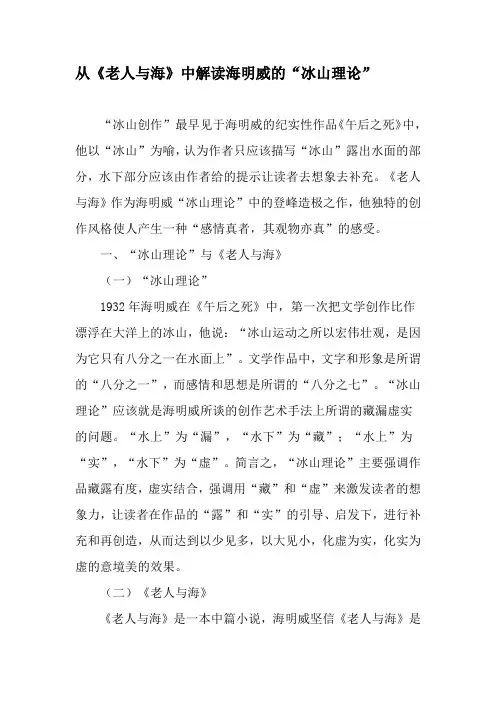
从《老人与海》中解读海明威的“冰山理论”“冰山创作”最早见于海明威的纪实性作品《午后之死》中,他以“冰山”为喻,认为作者只应该描写“冰山”露出水面的部分,水下部分应该由作者给的提示让读者去想象去补充。
《老人与海》作为海明威“冰山理论”中的登峰造极之作,他独特的创作风格使人产生一种“感情真者,其观物亦真”的感受。
一、“冰山理论”与《老人与海》(一)“冰山理论”1932年海明威在《午后之死》中,第一次把文学创作比作漂浮在大洋上的冰山,他说:“冰山运动之所以宏伟壮观,是因为它只有八分之一在水面上”。
文学作品中,文字和形象是所谓的“八分之一”,而感情和思想是所谓的“八分之七”。
“冰山理论”应该就是海明威所谈的创作艺术手法上所谓的藏漏虚实的问题。
“水上”为“漏”,“水下”为“藏”;“水上”为“实”,“水下”为“虚”。
简言之,“冰山理论”主要强调作品藏露有度,虚实结合,强调用“藏”和“虚”来激发读者的想象力,让读者在作品的“露”和“实”的引导、启发下,进行补充和再创造,从而达到以少见多,以大见小,化虚为实,化实为虚的意境美的效果。
(二)《老人与海》《老人与海》是一本中篇小说,海明威坚信《老人与海》是他“一辈子所能写出最好的一部作品,别的优秀而成熟的作品与它相比大为逊色。
可以作为我全部创作的尾声,作为我写作、生活中已经学到或者想学的这一切的尾声。
”作为海明威冰山创作中最具有代表性的作品,《老人与海》将小说情节浓缩在不到三千万字的篇幅中。
在小说中作者文字只是触及到只有“八分之一”,而剩下的“八分之七”的思想感情都蕴含在水面之下。
读者可以通过水面的“八分之一”去感受剩下的“八分之七”。
作品讲述了桑迪亚哥独自一人在深海中捕鱼斗鲨的故事,小说的主题可以简单的概括为一句话:“人不是为失败而生的,一个人可以被毁灭,但不能被打败。
”在文章中,作者用简约的文字风格去展现其“冰山理论”的创作风格。
小说人物原型来源于社会现实,描写半实半虚似幻似真,靠表意得力见长,这一切完全源于海明威煞费苦心的“冰山理论”。

开题报告《老人与海》中硬汉形象分析学士学位论文开题报告文理学院英语系Analysis of “Code Hero” in The Old Man and Sea《老人与海》中硬汉形象分析学生姓名:指导教师:年级:2008级2班专业:英语学号: 2011年10月18日课题来源:由指导教师帮助自拟题目题目:Anal ysis of “Code Hero” in The Old Man and the Sea《老人与海》中硬汉形象分析课题研究的目的和意义:海明威是美国著名的小说家之一,小说《老人与海》使其获得了1954年的诺贝尔文学奖。
在此小说中,作者创造了一个完美的硬汉形象――桑地亚哥。
《老人与海》是一件影响广泛,寓意深刻的世界文学瑰宝,它广泛地为大众所阅读,以至有人这样认为“只要是个文化人,你就会知道海明威其人。
知道海明威,你就不可能不知道小说《老人与海》。
”为什么这部小说如此被广泛的阅读?当然,诸多方面造就了小说的成功,但是有一点,毋庸置疑,那就是作者对小说主人公桑地亚哥这一永恒的艺术形象的成功塑造给人深刻印象,让人难以忘记这个硬汉形象的代表。
本文通过对《老人与海》的“硬汉形象”的分析,体会老人面对困难毫不退缩的内心世界。
学习老人刚毅、坚韧的硬汉性格和无所畏惧的拼搏精神。
老人表现出来的是一种必胜的信念和顽强的性格是一种精神的不屈唱出了一个人并不是生来就可以打败的你尽可能消灭他可就是打不败他这曲人类精神的赞歌鼓舞着一代又一代的人具有划时代的意义老人与海自诞生之日即成为国内外读者和评论界研究焦点在2000年以前半个世纪里读者和论者较多地关注作品中所表现出的硬汉形象、虚无思想、悲剧意识和冰山理论等研究成果比较丰富新世纪以来老人与海依然是学界研究的重镇研究视点主要集中在生态批评、艺术形式、性别角色等几个方面同时对于冰山理论、硬汉形象、象征功能、悲剧意蕴等方面的研究既有重复又有所超越因此收获与缺憾并存我国文学界对海明威的研究开始于三十年代。
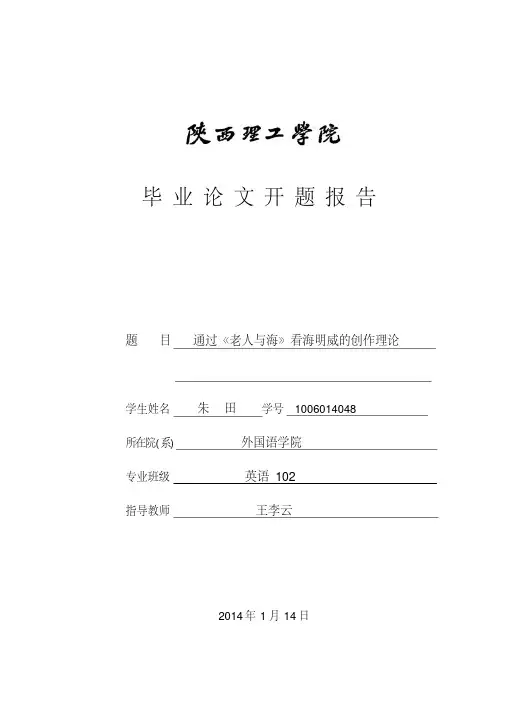
毕业论文开题报告题目通过《老人与海》看海明威的创作理论学生姓名朱田学号 ********** 所在院(系) 外国语学院专业班级英语102指导教师王李云2014年1月14日题目通过《老人与海》看海明威的创作理论一、选题的目的及研究意义选题目的20世纪现实主义文学在其发展的初始阶段就注定了将拥有不平凡的思想主题,追求崭新的文学风格成为20世纪现实主义作家的主要努力方向。
作为20世纪美国文坛上极具个性的作家,海明威提出了文学创作中的冰山理论,为20世纪现实主义文学带来了一阵清风。
本文以《老人与海》为例,通过分析小说中简洁的文字风格和大量的白描、象征写作手法,详细的对“冰山”理论进行研究,来展现其以少胜多的创作理论。
研究意义作为20世纪美国文坛上极具个性的作家,海明威于1932年在作品《午后之死》中第一次提出了文学创作中的“冰山理论”。
海明威向读者奉献了自己独具文学价值和艺术风格的“八分之一在水上,八分之七在水下”的冰山创作理论,简洁的文字风格、白描和象征手法的运用则是这一理论的完美体现,它向读者传递了丰富的内容和深邃的思想,有着一种言有尽而意无穷的艺术境界。
通过对这部作品的分析和研究,让人们对“冰山理论”这一写作特点有更深层次的学习和了解,体会文学作品写法的博大精深。
同时,在英语教学和英语写作也有一定的指导意义,并且在英语跨文化交际中的深入研究有很大的指导意义。
二、综述与本课题相关领域的研究现状、发展趋势、研究方法及应用领域等研究现状《老人与海》为海明威日益沉寂的写作生涯注入了生机与活力。
该作品获得了1953年普利策小说奖。
翌年,该作品由于受到了诺贝尔文学委员会的普遍赞誉而使海明威获得了诺贝尔文学奖。
对该作品中运用的冰山写作理论,学术界也有很多的研究:1.阿尔伯特·戴佛兹奥所编辑的《纪念海明威:回顾和展望》(1999年)一文中总结说:“自从严肃地海明威研究于1952年出现以来,已有一些评论家提供了回顾性和前瞻性的评论。
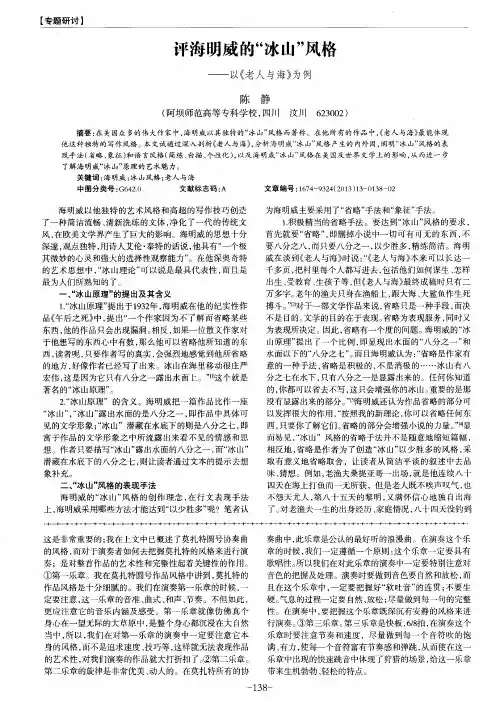

188佳木斯职业学院学报2020年第2期总第207期No.2. 2020Sum 207美国著名小说家海明威深谙叙事艺术,在中篇小说《老人与海》中,简约不简单的写作风格,自己称之为“冰山理论”“冰山风格”,作品中描述出的内容是冰山露出水面的部分,而留给读者自己想象和补充的内容则是冰山隐藏在水中的部分,这种创作风格带给人们“感情真者,其观物亦真”的一种感受。
一、探索和剖析冰山理论的出现(一)冰山理论的概念冰山理论最早由心理学家弗洛伊德提出,他在研究中指出,人的人格有意识的层面只是冰山的一角,人的心理行为是占据冰山下面看不见的巨大部分,正是这部分决定和影响人类的行为。
海明威纪实性作品《午后之死》一文中,第一次将文学创作比喻成漂浮在大洋中的冰山。
海明威表示:“冰山运动之所以雄伟壮观,是因为它只有八分之一在水面上。
文学作品中,文字和形象是所谓的‘八分之一’。
”文学作品中,情感与思想是隐藏在水面下的八分之七,这种虚实结合的写作手法,用“虚和藏”激发读者的想象力,用“露与实”的内容引导读者思考和再创造,进而达到以少见多与化虚为实的效果。
在文学创作中应用冰山理论写作手法,将有助于增加作品内涵的深度[1]。
(二)海明威冰山理论的形成海明威小说作品冰山理论的形成与其自身经历有着紧密的联系,我们主要从四个方面介绍。
1.海明威早年记者的经历,其从业的《堪萨斯城明星报》行文简短明快,语言生动活泼,新闻的规则化也潜移默化地融入文学写作中,在他的文学创作中,很少使用修饰语和形容词。
2.海明威善于学习,其他作家的语言风格对他影响颇深,例如马克吐温作品的短字和短句,斯泰因的简单句法,庞德笔法的简练含蓄等。
海明威创新性的学习与应用逐渐形成自己独有的冰山理论风格。
3.海明威亲身经历西班牙内战,也参加过二战,惨烈战争所带来的创伤影响到他的作品创作,他采用客观凝练的语言风格,塑造出作品中主人公坚忍寡言的硬汉形象,这些存在在那个被战争摧毁的时代显得更加真实和有意义[2]。
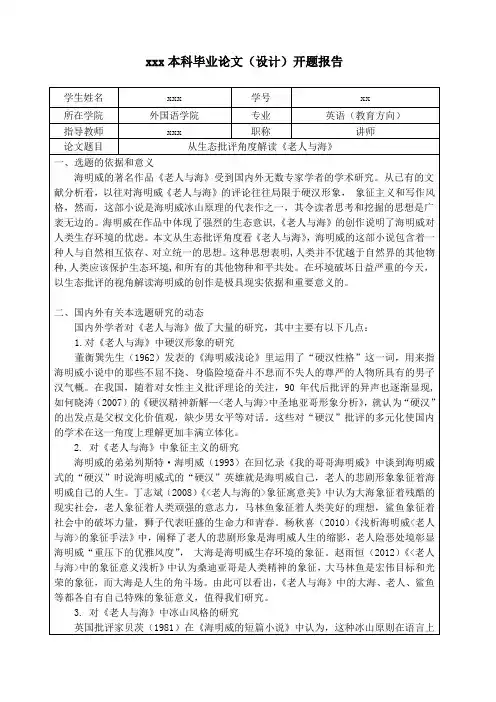
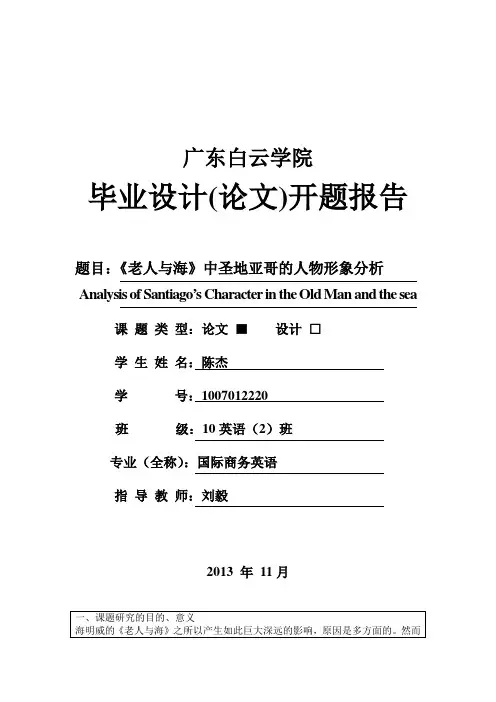
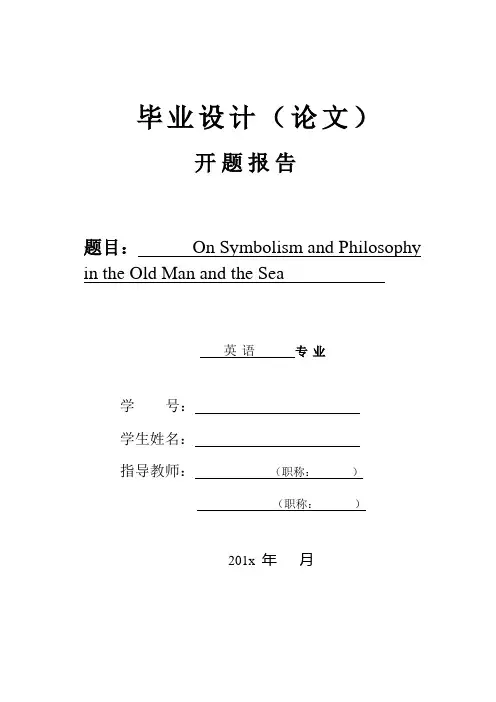
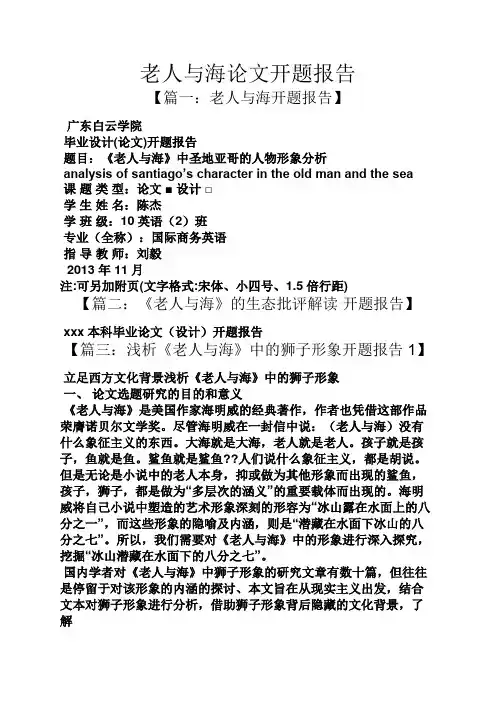
老人与海论文开题报告【篇一:老人与海开题报告】广东白云学院毕业设计(论文)开题报告题目:《老人与海》中圣地亚哥的人物形象分析analysis of santiago’s character in the old man and the sea课题类型:论文■ 设计□学生姓名:陈杰学班级:10英语(2)班专业(全称):国际商务英语指导教师:刘毅2013 年 11月注:可另加附页(文字格式:宋体、小四号、1.5倍行距)【篇二:《老人与海》的生态批评解读开题报告】 xxx本科毕业论文(设计)开题报告【篇三:浅析《老人与海》中的狮子形象开题报告1】立足西方文化背景浅析《老人与海》中的狮子形象一、论文选题研究的目的和意义《老人与海》是美国作家海明威的经典著作,作者也凭借这部作品荣膺诺贝尔文学奖。
尽管海明威在一封信中说:(老人与海)没有什么象征主义的东西。
大海就是大海,老人就是老人。
孩子就是孩子,鱼就是鱼。
鲨鱼就是鲨鱼??人们说什么象征主义,都是胡说。
但是无论是小说中的老人本身,抑或做为其他形象而出现的鲨鱼,孩子,狮子,都是做为“多层次的涵义”的重要载体而出现的。
海明威将自己小说中塑造的艺术形象深刻的形容为“冰山露在水面上的八分之一”,而这些形象的隐喻及内涵,则是“潜藏在水面下冰山的八分之七”。
所以,我们需要对《老人与海》中的形象进行深入探究,挖掘“冰山潜藏在水面下的八分之七”。
国内学者对《老人与海》中狮子形象的研究文章有数十篇,但往往是停留于对该形象的内涵的探讨、本文旨在从现实主义出发,结合文本对狮子形象进行分析,借助狮子形象背后隐藏的文化背景,了解狮子形象的几重内涵,掌握狮子形象的立足核心。
从而对海明威及其作品《老人与海》有更加深刻的认识,加深对西方20世纪现实主义文学的理解,以便建立更加成熟立体的文学观念。
二、国内研究现状海明威对《老人与海》的自我评价是:这是我一生打到的最大最好的狮子,名副其实。
这一作品诞生以来,就已经成为文学评论家和文学研究者的宠儿。

1、题目《老人与海》中的象征意义所体现的“冰山原则”2、选题的目的与意义2.1选题的目的海明威的“冰山理论”是对19世纪末20世纪初盛行的日益繁琐的文学写法的偏离和背叛。
国内外的文学批评家对其大加赞赏,都对其进行了研究和探讨。
“冰山原则”是时代的需要,反映出时代的风貌,开创了一代文风,但在实际中还有一些残缺,作为一种创作原则,“冰山原则”的影响是永恒的。
本文就是通过中外批评家的观点,集合海明威自己看法,通过深入分析《老人与海》这一作品,对海明威的创作风格——“冰山原则”进行了探讨。
本文分析了该原则的四大构成要素,通过研究文章中多重形象的象征意义,详细分析了“冰山原则”在《老人与海》中的体现,着重分析其冰山下隐藏的“八分之七”,以此揭开其“以少见多”的深层意义和艺术魅力以及折射出的艺术与生活的关系。
文章最后还简单介绍了海明威的创作风格在美国及世界文学上和社会意义上的贡献。
2.2选题的意义2.2.1理论意义通过深入研究《老人与海》中多个形象的象征意义,对海明威的创作风格——“冰山原则”进行探讨研究,有利于这一理论的进一步发展和完善,并从理论的高度上加深是创作者和其他读者对这一创作原理的认识。
2.2.2现实意义通过对《老人与海》的深入研究,结合现实,引导创作者进一步探讨海明威创作原理“冰山原则”,揭开其“以少见多”的深层意义和艺术魅力以及折射出的艺术与生活的关系,进而掌握这一原理的实际应用技巧,进行更好的创作。
3、国内外同类研究的概况综述3.1作者及作品简介厄内斯特•海明威(1899-1961 )是20世纪美国小说家、短篇小说作家和最伟大的美国作家之一,是盛行于本世纪二三十年代的“迷惘的一代”文学流派公认的代表作家,被称为美国二十世纪上半期最有才华的天才小说家。
如果用一句话来概括他的为人,那就是:一个酷爱体育和运动的硬汉;一位世事练达的记者;一名浑身伤疤的战士;一位西班牙斗牛的狂热爱好者;一位既擅饮烈酒又讲究生活的美食家。
冰山原则在《老人与海》中的体现Iceberg Theory Embodied inThe Old Man and the SeaZhou HuiUnder the Supervisor ofYuan BinSchool of Foreign Languages and CulturesPanzhihua UniversityMay 2005Contents摘要 (I)关键词 (I)Abstract (II)Key words (II)Introduction (1)I. Introduction of Ernest Hemingway (2)II. Background and the Main Story (3)III. Three Deep Stratifications of the Iceberg Theory in the Novel (6)A. A Paean of Hero from the Perspective of the T heme (6)a. Function of the Old Man as Hemmingway’s Own C haracter (6)b. Function of the Boy as the Oedipus Complex of Hemmingway (7)B. Hemmingway’s Unconscious Desire and Writing from the Perspective of theF ishing (8)a. Santiago’s Dreams and Reveries Above the Water, and the UnderneathUnconscious Desire (9)b. The Fishing of the Old Man as the One-eighth Part, and the Hard Creativity ofthe Author as the Seven-eighths (10)C. An Ancient Greek Tragedy form the Perspective of the Source and R eligion (12)Conclusion (15)Bibliography (17)Acknowledgement………………………………………...…………….……….…...18摘要海名威以其简洁的文字,鲜明的形象,丰富的感情和深刻的思想构成了著名的“冰山原则”,牢固确立了他在美国历史上的地位,使他成为美国历史上最具影响的作家之一。
老人与海开题报告开题报告:老人与海一、引言《老人与海》是美国作家海明威于1952年创作的一部小说,以老渔夫圣地亚哥与他的童子弟子马努林的故事为主线,讲述了一个关于坚持和尊严的故事。
本文将通过分析小说中的主要人物、情节及象征意义,探讨《老人与海》所传达的主题和价值观。
二、主要人物分析1. 圣地亚哥圣地亚哥是一个年过六旬的老渔夫,他孤独而坚毅,深受读者喜爱。
他代表着坚持和毅力的精神,不论是在捕鱼过程中的艰辛,还是在与巨大马林鱼搏斗时的顽强。
圣地亚哥的形象展现了一个老人的尊严和自信,他的坚持和勇敢激励着读者面对生活中的挑战。
2. 马努林马努林是圣地亚哥的小伙伴,他是一个年轻而聪明的小渔夫。
尽管年纪轻轻,马努林对圣地亚哥充满敬意,并且愿意为他付出。
他是圣地亚哥的学生和朋友,通过他的形象,作者传达了师徒情谊和相互扶持的重要性。
三、情节分析1. 圣地亚哥与马林鱼的搏斗小说的高潮部分是圣地亚哥与一条巨大的马林鱼搏斗的情节。
这场搏斗持续了数天,圣地亚哥面对马林鱼的强大力量和顽强抵抗,最终成功捕获了鱼。
这一情节展现了人与自然的对抗,同时也表达了人类对于困境的坚持和克服困难的决心。
2. 圣地亚哥的孤独与坚持圣地亚哥在这个故事中是一个孤独的人,他独自一人在海上捕鱼,没有家人和亲人的陪伴。
然而,他并没有因此而放弃,他坚守自己的信念,努力追求自己的目标。
这种坚持和孤独给予读者一种思考,引发对人生意义和孤独的思考。
四、象征意义分析1. 马林鱼的象征意义马林鱼是小说中的重要象征物,它代表着人生中的挑战和困难。
马林鱼的巨大和强大力量象征着人类面对困境时的艰难和无助。
圣地亚哥与马林鱼的搏斗,象征着人类面对困难时必须要有坚持和勇气。
2. 海洋的象征意义海洋在小说中是一个重要的象征,它代表着无尽的可能性和未知的未来。
圣地亚哥在海上捕鱼,他面对的是无边无际的大海,这象征着人类面对未来时的不确定性和挑战。
海洋也象征着生命的源泉和无穷的力量。
. ... .摘要《老人与海》是海明威于1951年在古巴写的一篇中篇小说,它是海明威创作并在他还在世时出版的最后一部主要的虚构作品。
在书中海明威描述了一个老人出海捕鱼全部过程的故事。
无论是从语言结构、叙事技巧还是象征手法角度来看,《老人与海》将文学的可感性与思想性巧妙地结合起来,犹如一座冰山,有实有虚有藏有露,让读者去感受并发掘其内在的意义。
本文正是通过对《老人与海》的语言结构、叙事技巧、和象征手法三个方面的研究,对海明威所倡导的“冰山原则”进行探讨,挖掘书中深藏的意蕴。
关键词:《老人与海》,圣地亚哥,冰山原则Abstract“The Old Man and the Sea” is Ernest Hemingway in 1951 in Cuba wrote amedium-length novel, it is Ernest Hemingway to create and when he was alive the last part of the main published fiction. In book description Hemingway in a old man fishing all the story of the process. Whether from the language structure, narrative skills or symbolism Angle, the old man and the sea "of literature can be emotionally and will be thoughtful combined skillfully, like an iceberg, have actual empty houses the dew, let the reader to experience and explore the inner meaning.Key words:The Old Man and the Sea, Iceberg Principle, Santiago目录绪论 (III)一、语言、结构简练直白却富有深蕴 (IV)(一)平实的语言带深厚意蕴 (IV)(二)结构凝练,能省即省 (V)二、叙事技巧 (VII)三、象征手法的运用 (VIII)(一)孩子的象征意义 (VIII)(二)大马林鱼的象征意义 (VIII)(三)狮子的象征意义 (IX)结论 (X)参考文献: (XI)致谢 (XII)绪论厄内斯特·海明威(1899—1961)作为二十世纪美国最著名的作家之一,尤其以精湛的叙事艺术见长。
“老人与海”和美国精神的开题报告“老人与海”是海明威的一部小说,描述了一个叫做桑提亚哥的老渔夫在海上捕鱼的故事。
这个故事表现了许多美国精神的特征,包括勇气、毅力、自立、挑战、团结以及不屈不挠的精神。
首先,勇气是美国精神的一个重要组成部分。
在小说中,桑提亚哥展现出了极高的勇气。
虽然他在海上捕鱼的过程中经历了许多艰难困苦,但他从来没有放弃过,永远坚持到底。
他甚至与一条大马林鱼斗争了三天三夜,最终胜利了。
这种顽强的勇气无疑是一个真正的美国精神。
其次,毅力也是美国精神中的一个核心特征。
桑提亚哥一直保持着坚定的信念和决心,无论遇到任何困难,他都会努力克服。
他相信自己可以克服困难,并决心不放弃,这种毅力非常值得人们学习。
自立也是美国精神的重要方面。
桑提亚哥是一个自给自足的渔民,凭借自己的智慧和劳动,勇敢地面对大海。
他不依赖任何人,也没有任何人依赖他。
这种自立的态度在美国文化中被高度赞赏。
挑战也是美国精神中的一个重要特征。
桑提亚哥通过寻找更大的鱼来挑战自己的极限。
通过不断地挑战自己,他得到了进一步的成长和发展。
团结也是美国精神中的一个关键特征。
桑提亚哥是一个独自作战的人,但他也感受到了其他人的支持和鼓励。
他深知没有别人的支持和鼓励,他无法完成自己的目标。
在美国文化中,重视团结和协作是非常重要的。
最后,不屈不挠的精神也是美国文化的核心特征之一。
桑提亚哥虽然经历了一次次的失败和挫折,但他从来没有放弃过。
他始终保持着积极和乐观的态度,这种精神对于所有人来说都是非常重要的。
总之,“老人与海”这个故事展现了许多美国精神的特征,包括勇气、毅力、自立、挑战、团结以及不屈不挠的精神。
这些特征也是美国文化的重要组成部分,激励着人们在生活中不断追求自己的梦想和目标。
老人与海开题报告老人与海开题报告《老人与海》是美国作家海明威创作的一部长篇小说,于1952年出版。
这部小说以古巴渔夫圣地亚哥为主人公,讲述了他与一条巨大的马林鱼搏斗的故事。
小说通过描绘圣地亚哥的孤独、坚韧和对生命的执着,探讨了人与自然、人与命运的关系。
本文将从人物形象、自然意象和主题等方面展开论述,深入探讨《老人与海》这一经典作品。
首先,小说中的主人公圣地亚哥是一个老年渔夫,他孤独而坚韧,具有强烈的意志力。
他在渔船上独自面对艰难困苦的捕鱼过程,展现了他对生命的执着和追求。
圣地亚哥的形象象征着人类的坚韧不拔和对生命的热爱。
他与大自然的搏斗,体现了人与自然的关系。
小说中的其他人物形象也各具特色,如圣地亚哥的小伙伴马努林和他的村庄邻居。
这些人物形象的塑造丰富了故事情节,使读者更容易产生共鸣。
其次,自然意象在《老人与海》中起到了重要的作用。
作者通过对大海、鱼和鲨鱼等自然元素的描绘,增强了小说的艺术感染力。
大海象征着无尽的力量和未知的命运,与圣地亚哥的命运紧密相连。
鱼是圣地亚哥的对手,它们巨大而强大,与圣地亚哥的斗争使整个故事更加紧张刺激。
鲨鱼则象征着挑战和危险,它们对圣地亚哥捕到的鱼进行了破坏,使他的努力付诸东流。
通过自然意象的运用,作者巧妙地展示了人与自然的关系,使读者对大自然的力量和人类的脆弱有了更深刻的认识。
最后,小说的主题是人类对命运的抗争和对生命的热爱。
圣地亚哥在与巨大马林鱼的搏斗中,展现了他顽强的意志和不屈不挠的精神。
尽管最终失败了,但他并没有放弃,而是继续追求自己的理想。
这种对命运的抗争和对生命的热爱是小说的核心主题。
通过圣地亚哥的经历,作者传达了一个重要的信息:即使在困境中,我们也应该坚持追求自己的目标,不屈不挠地面对挑战。
总之,《老人与海》是一部充满深度和情感的作品。
通过对人物形象、自然意象和主题的细致描绘,作者成功地展示了人与自然、人与命运的关系。
这部小说不仅给人以启示和思考,同时也给读者带来了对生命的热爱和对困境的勇敢面对的力量。
1、题目《老人与海》中的象征意义所体现的“冰山原则”2、选题的目的与意义2.1选题的目的海明威的“冰山理论”是对19世纪末20世纪初盛行的日益繁琐的文学写法的偏离和背叛。
国内外的文学批评家对其大加赞赏,都对其进行了研究和探讨。
“冰山原则”是时代的需要,反映出时代的风貌,开创了一代文风,但在实际中还有一些残缺,作为一种创作原则,“冰山原则”的影响是永恒的。
本文就是通过中外批评家的观点,集合海明威自己看法,通过深入分析《老人与海》这一作品,对海明威的创作风格——“冰山原则”进行了探讨。
本文分析了该原则的四大构成要素,通过研究文章中多重形象的象征意义,详细分析了“冰山原则”在《老人与海》中的体现,着重分析其冰山下隐藏的“八分之七”,以此揭开其“以少见多”的深层意义和艺术魅力以及折射出的艺术与生活的关系。
文章最后还简单介绍了海明威的创作风格在美国及世界文学上和社会意义上的贡献。
2.2选题的意义2.2.1理论意义通过深入研究《老人与海》中多个形象的象征意义,对海明威的创作风格——“冰山原则”进行探讨研究,有利于这一理论的进一步发展和完善,并从理论的高度上加深是创作者和其他读者对这一创作原理的认识。
2.2.2现实意义通过对《老人与海》的深入研究,结合现实,引导创作者进一步探讨海明威创作原理“冰山原则”,揭开其“以少见多”的深层意义和艺术魅力以及折射出的艺术与生活的关系,进而掌握这一原理的实际应用技巧,进行更好的创作。
3、国内外同类研究的概况综述3.1作者及作品简介厄内斯特•海明威(1899-1961 )是20世纪美国小说家、短篇小说作家和最伟大的美国作家之一,是盛行于本世纪二三十年代的“迷惘的一代”文学流派公认的代表作家,被称为美国二十世纪上半期最有才华的天才小说家。
如果用一句话来概括他的为人,那就是:一个酷爱体育和运动的硬汉;一位世事练达的记者;一名浑身伤疤的战士;一位西班牙斗牛的狂热爱好者;一位既擅饮烈酒又讲究生活的美食家。
海明威的思想十分深邃,而且观点独特,用诗人艾伦·泰特的话说,他具有“一个极其微妙的心灵和强大的选择性观察能力”。
海明威的小说通常侧重于处于充满危险的生活中的军人,渔民,运动员,斗牛士等等。
他既描写人类面临的灾难和虚空,又表现人在逆境下的勇气和尊严。
他的主人公可能迷惘绝望,但在痛苦面前却谈笑若定,决不放弃男子汉的气度。
海明威的文风继承马克·吐温的口语体传统,文字质朴无华,但蕴涵却极为丰富。
他著名的作品主要包括《太阳照常升起》(1926年),《永别了,武器》(1929年),《丧钟为谁而鸣》(1940年),《老人与海》(1952年)等等。
3.2与选题相关的国内外研究和发展概况3.2.1选题的相关概况1932年,海明威在他的纪实性作品《午后之死》中,第一次把文学创作比做漂浮在大洋上的冰山,他说:“冰山运动之雄伟壮观,是因为他只有八分之一在水面上。
”其后,有多次作过这样的比喻。
海明威这种形象的比喻,引起了文学批评界的兴趣。
于是,所谓“冰山原则”就成了文学批评界研究海明威创作的重要课题之一。
可以说冰山原则”是海明威对自己多年创作经验的形象总结,是他处理艺术和生活关系所遵循的基本准则。
这种思想使得海明威的语言很简洁,形成了海明威式的语言特点。
对于“冰山原则”,海明威自己在《午后之死》中有一个解释,他写道:“如果一位散文家对于他想写的东西心里很有数,那么他可能省略他所知道的东西,读者呢,只要作家写得真实,会强烈的感觉到他所省略的地方,好像作者写出来似的。
”显而易见,作家在这里强调的是省略,主张水面下的的“八分之七”应该留给读者去感受。
根据海明威的解释,可以对“冰山原则”作一个粗略的概括:所谓“冰山原则”,就是用简洁的文字塑造出鲜明的形象,把自身的感受和思想情绪最大限度的埋藏在形象之中,使之情感充沛却含而不露、思想深沉而隐而不晦,从而将文学的可感性与可思性巧妙的结合起来,让读者对鲜明形象的感受去发掘作品的思想意义。
3.2.2与选题相关的国外研究概况英国批评家贝茨在《海明威的短篇小说》一文中认为,这种“冰山原则”在语言上表现为删掉了小说中几乎所有的解释、探讨,甚至议论;砍掉了一切花花绿绿的比喻;剥下了亨利·詹姆斯时代句子长、形容词多得要命的华丽外衣。
“掌握暗示的艺术,用一句话说明两件或两件以上不同事情的艺术,那就把短篇小说家要干的活儿完成了多一半。
”“他以谁也不曾有过的勇气把英语中附着于文学的乱毛剪了个干净。
”这些英语文学的乱毛中被海明威收拾得最利索的是形容词。
形容词过多是十九世纪末以亨利·詹姆斯为代表的小说家带给英语文学的一大灾难。
譬如詹姆斯的代表作《贵妇人的画像》充斥了长句子和多重修饰,“你不憋足一口长气是读不完一个句子的,好比一长列货车,站在它面前望不到尽头”(董衡巽语)。
这绝对是学者型的文风。
而海明威18岁就去打仗,根本没有机会进行科班训练,打过仗当了美国一家报纸驻欧洲的记者,写文章和报道要用电报发回国,语言必须简明,于是形成了一种所谓的“电报体风格”,极少用修饰语,极少用形容词。
可以说文学史上有一类作家是敌视形容词的。
法国大文豪伏尔泰就有句名言:“形容词是名词的敌人。
”他似乎在说只有名词是直抵事物本身,是直面、直接呈示事物,形容词多了反而遮蔽事物和内质,所以是名词的敌人。
美国艺术批评家马儿科姆指出:“你从生活中提取那些唤起了自己情绪的鲜明细节,如果你对暴行与恐怖并不闭目塞听,而按照适当的顺序准确地描述了这些细节,那么你就写出了会依旧唤起读者的情绪的东西来。
”这就是海明威在他早期特写中遵循的方法,这种方法在其自行限定的范围内是极其成功的,甚至在其范围以外,他也是成功的,因为他所描绘的图景表明具有一种广泛的暗示力。
”美国批评家艾德尔对海明威的”冰山原则”是持否定态度的,他认为这是“回避的手法”,“甩开情绪来造成一种情绪的气氛”。
3.2.2与选题相关的国内研究概况我国小说家马原认为“冰山理论”的更内在的质素可以概括为“经验省略”。
他指出开始许多评论家把海明威的省略与传统的留空白理论等同起来,以为这是一种含蓄手法的运用,言有尽而意无穷,这是一个大的失误。
传统的省略方法很类似于删节号的作用,它省略的是情味和韵致;而海明威省略的则是完全不同质的东西——实体经验。
马原以《永别了武器》中曾被海明威改写了三十九遍(在另一处海明威又说是四十遍)的结尾为例,说明作者利用了人所共有的感知方式及其规律,不说大家都知道的东西,结果大家还是都知道了。
这样做除了因省略掉一些东西而缩短了篇幅外,由这种省略还产生了完全出人意料的新的审美方法,以作用于(阅读)对象心理为根本目标的方法。
(马原《小说》)4、研究计划4.1研究内容本文就是通过中外批评家的观点,集合海明威自己看法,通过深入分析《老人与海》这一作品,对海明威的创作风格——“冰山原则”进行了探讨。
本文分析了该原则的四大构成要素,通过研究文章中多重形象的象征意义,详细分析了“冰山原则”在《老人与海》中的体现,着重分析其冰山下隐藏的“八分之七”,以此揭开其“以少见多”的深层意义和艺术魅力以及折射出的艺术与生活的关系。
4.2研究方法采用文献研究的方式,通过阅读研究有关的文献资料和专著,并对资料进行整理和归纳,为文章的阐述提供理论依据。
获得文献的具体方法有,一是大量阅读图书馆的与之相关的期刊杂志,并做出记录及分析;二是广泛的搜索与课题相关的网络信息,并对其进行编辑整理,以供写作本文参考之用;三是充分利用学校图书馆的已购数据库,从数据库中搜索到大量相关论文,在仔细阅读的基础上,做出了深刻细致的分析,从中得到启迪,形成了本文的构思、框架的来源。
4.3便利指数学校提供了图书馆、电子阅览室等有利场所,便于我们进行查找和搜索资料,针对“冰山原则”的专著和文献资料方面比较充足。
4.4研究中可能遇到的困难本文主要通过分析《老人与海》这一作品中多个形象的象征意义,进一步探讨海明威的创作风格——“冰山原则”。
针对该内容,需要大量国内外中英文文献资料。
主要困难为与“冰山理论”相关的国内外最新研究资料信息无法及时获得。
4.5预期的研究结果通过深入研究《老人与海》中多个形象的象征意义,对海明威的创作风格——“冰山原则”进行探讨研究,期望能够进一步了解“冰山原则”的内涵,掌握这一原理的实际应用技巧,进行更好的创作。
4.6所做研究内容的创新之处将小说中众多的形象结合起来,分析其象征意义,进而在分析中探讨“冰山原则”的含义及应用。
5、论文大纲1简介1.1“冰山原则”“冰山原则”有两个层面的含义:一是简约的艺术。
即删掉小说中一切可有可无的东西,以少胜多,象中国水墨画技巧,计白当黑,不要铺陈,不要八分之八,而只要八分之一。
二是实体经验省略。
海明威省略的其实是我们凭经验可以填充想象的部分,因此,这种省略技巧就最大限度地调动了读者的经验参与,使读者觉得作家很信任自己的理解力和经验能力。
在这个意义上,海明威等于把冰山的八分之七空在那里让读者自己凭经验去填充。
1.2 中外评论家对“冰山原则”的讨论1.2.1外国评论家对“冰山原则”的讨论主要为英国批评家贝茨、美国艺术批评家马儿科姆以及美国批评家艾德尔对“冰山原则”的讨论。
1.2.2中国评论家对“冰山原则”的讨论主要为我国小说家马原对“冰山原则”的评论。
1.3 “冰山原则”的四个基本要素简洁的文字、鲜明的形象、丰富的情感和深刻的思想是构成”冰山原则”的四个基本要素。
具体地说,文字和形象是所谓的“八分之一”,而情感和思想是所谓的“八分之七”。
前两者是具体可见的,后两者是寓于前两者之中的。
文字塑造了形象,形象包含了情感,而情感之中蕴涵着思想。
诚然,就一般文学作品而言,这四个要素都是必不可少的,但在海明威的作品中显得尤为突出,因为他强调了情感和思想的含蓄性。
2《老人与海》中的象征意义所体现的“冰山原则”2.1 《老人与海》的主要思想老渔夫桑提亚哥在海上连续84天没有捕到鱼。
起初,有一个叫曼诺林的男孩跟他一道出海,可是过了40天还没有钓到鱼,孩子就被父母安排到另一条船上去了,因为他们认为孩子跟着老头不会交好运。
第85天,老头儿出乎意料地钓到了一条比船还大的马林鱼。
老头儿和这条鱼周旋了两天,终于叉中了它。
但受伤的鱼在海上留下了一道腥踪,引来无数鲨鱼的争抢,老人奋力与鲨鱼搏斗,但回到海港时,马林鱼只剩下一付巨大的骨架,老人也精疲力尽地一头栽倒在陆地上。
孩子来看老头儿,他认为桑提亚哥没有被打败。
那天下午,桑提亚哥在茅棚中睡着了,梦中他见到了狮子。
“一个人并不是生来要被打败的,你尽可以把他消灭掉,可就是打不败他。
”这是桑提亚哥的生活信念,也是《老人与海》中作者要表明的思想。
2.2 文中的象征意义体现的“冰山原则”2.2.1 老渔夫圣地亚哥的象征意义老渔人桑提亚哥是海明威塑造的最后一位悲剧英雄,也是他一生塑造的硬汉性格的最后总结。